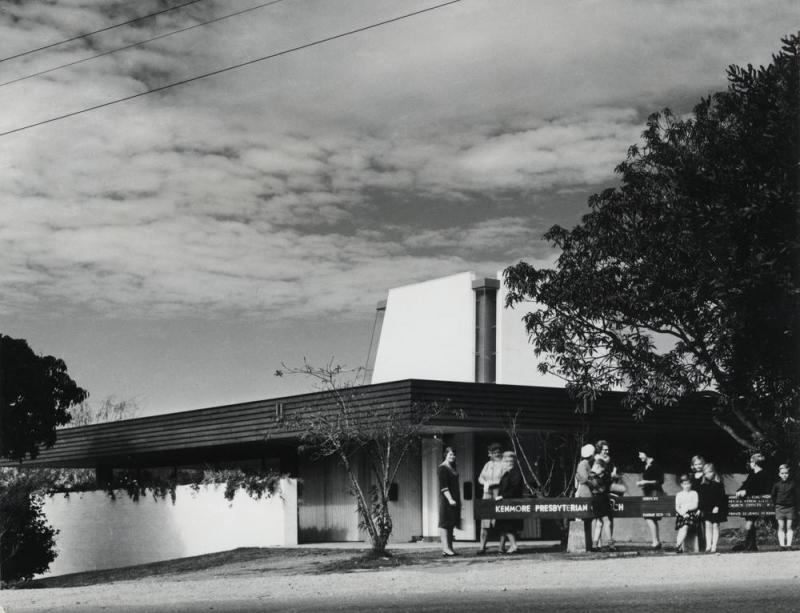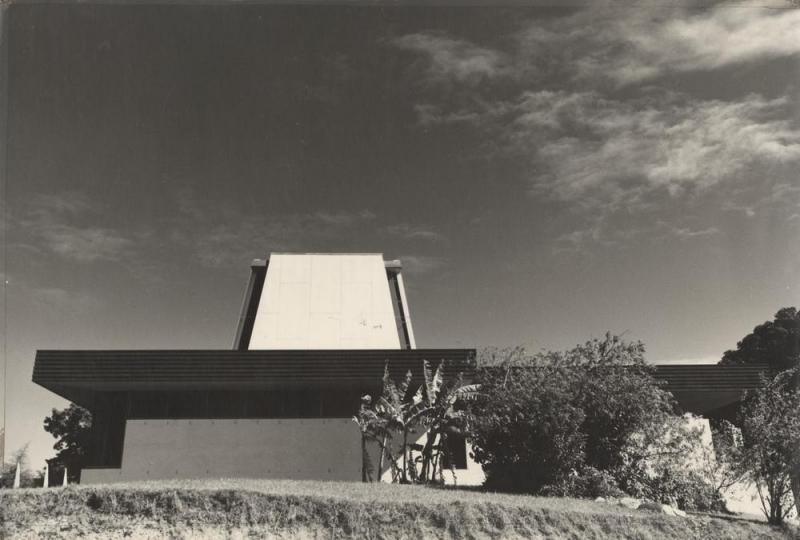Addresses
Type of place
Church
Period
Victorian 1860-1890, Late 20th Century 1960-1999
Style
Carpenter Gothic, Late Modern
Addresses
Type of place
Church
Period
Victorian 1860-1890, Late 20th Century 1960-1999
Style
Carpenter Gothic, Late Modern
The Kenmore Presbyterian Church was built in 1885 in Kenmore Road. The architect was Andrew Whitecross of the Public Works Department and local farmer and carpenter Mr. Squires constructed the church. It was officially opened on 4 October 1885 by Reverend D. F. Mitchell of South Brisbane. The pulpit and organ were added in 1887, and a spire and eight tubular bells were added in 1952. By 1966 as suburban development in the area increased and the congregation grew, a new and larger church and hall was required. Architect Robin Gibson was engaged to design the complex. In 1968 work was complete and the Queensland Chapter of the Royal Australian Institute of Architects awarded the Kenmore Presbyterian Church “Building of the Year”. It became a Uniting Church in 1977. The original church was relocated to the Moggill Road site in 1968.
Also known as
Kenmore Uniting Church
Lot plan
L2_RP108088; L4_RP108088; L3_RP108088
Key dates
Local Heritage Place Since —
Date of Citation —
Construction
Roof: Corrugated iron;Roof: Ribbed metal;
Walls: Masonry - Render;
Walls: Timber
People/associations
Alexander Whitecross - 1885 Church (Architect);Mr. Squires - 1885 Church (Builder);
Robin Gibson - 1968 Church (Architect)
Criterion for listing
(A) Historical; (D) Representative; (E) Aesthetic; (F) Technical; (G) Social; (H) Historical associationInteractive mapping
Also known as
Kenmore Uniting Church
Lot plan
L2_RP108088; L4_RP108088; L3_RP108088
Key dates
Local Heritage Place Since —
Date of Citation —
Construction
Roof: Corrugated iron;Roof: Ribbed metal;
Walls: Masonry - Render;
Walls: Timber
People/associations
Alexander Whitecross - 1885 Church (Architect);Mr. Squires - 1885 Church (Builder);
Robin Gibson - 1968 Church (Architect)
Criterion for listing
(A) Historical; (D) Representative; (E) Aesthetic; (F) Technical; (G) Social; (H) Historical associationInteractive mapping
History
A period of economic boom for Brisbane, the mid 1880s was also a time of resurgence for the Presbyterian Church in Queensland. The first Presbyterian church had been erected by its congregation in 1850, and more churches followed in Brisbane and country towns throughout the next two decades. However from the mid 1870s, the growth of the Presbyterian community slowed dramatically throughout Queensland, and in 1881 the Convenor of the Church Extension Committee, the Reverend Colin McCulloch, noted that "our Church is not extending, but rather the reverse". Adherents to the Presbyterian religion made up just 12.4% of the State population at that time.
Perhaps the improving economy of the mid-1880s provided a more stable population, as the church began to expand in country and metropolitan centres, so that by 1886 13.7% of the Queensland population was recorded as Presbyterian. It was during this growth period, early in 1885, that residents of the Kenmore district who were members of the Brookfield Presbyterian Congregation, decided to seek a more central location and build their own church.
Local resident Andrew Todd generously presented the new congregation with half an acre of land in Kenmore Road on which to build a church. Alexander Whitecross, who was Foreman of Works from 1875-79, drew up plans for the church for a fee of £1 and a local carpenter and farmer, Mr Squires, built the church with a completion cost of £1,708. Whitecross supervised the erection of police and school buildings, and later the construction of defence buildings at Lytton. The church was opened on 4 October 1885 by Rev D.F. Mitchell of South Brisbane. The Sunday School began on 6 December 1885 as an important feature of the church. A pulpit was supplied by the Home Mission in 1887, along with an organ donated by Mrs Gibson. In 1952, a spire and eight tubular bells were added to the Church and these remain a prominent feature.
During the 1960s the congregation again expanded, and it was decided to build a larger church and hall on land in Moggill Road. On 24 February 1968 the new development was completed to the designs of architect, Robin Gibson. That year the Kenmore Presbyterian Church was awarded Building of the Year by the Queensland Chapter of the Royal Australian Institute of Architects. The jury, consisting of J. Dalton, W. Grieg, J. Railton, G. Petersen and N. Miller commented in their report that ‘The precise control of detail and choice of materials is particularly evident throughout the building and the judges were unanimous that the church is one of Queensland’s most significant buildings to have been built in the last decade”. Robin Gibson’s brief was that the church “was to be the central theme of a complex which contained a Christian Education Centre and a daily kindergarten.” Robin Gibson went on to win numerous awards, including Queenslander of the Year in 1982, the Order of Australia in 1983, and was awarded the RAIA Gold Medal for Outstanding Performance and Contributions in 1989.
The site in Kenmore Road was sold to fund the construction of the new church. After some difficulties with the Brisbane City Council's Planning Committee, the congregation succeeded in having the old church, now known as the 'Pioneer church', moved in 1968 to the semi-rural setting at the rear of the new church. In 1977, when the Uniting Church was formed by the amalgamation of Congregational, Presbyterian and Methodist Churches, the Kenmore Presbyterian Church was renamed the Kenmore Uniting Church. This church building has been the hub of the local congregation for almost 50 years.
Description
1885 Church:
This small Gothic style timber Church is set on concrete stumps and clad in chamfer boards. It has a steeply pitched corrugated iron roof and a square bell tower with pointed spire. Set well back from Moggill Road behind a modern church and administration centre, it sits on a steep grassy slope surrounded by trees.
The building consists of a central nave with an entry porch to one end and vestry to the other. Timber steps descend from both sides of the porch and from a door to the vestry. The church which has been relocated from a flatter site, is very intact. The three sets of stairs which access the building have been kept in their original form resulting in one set of steps to the porch (on the lower side of this steeper slope) no longer reaching the ground.
The two gable walls of the nave each feature a simple circular vent. Below these, the lower gable roofs of the front entry porch and rear vestry project. To each side of the porch, a single lancet window sits within the nave's front wall. Identical windows line the side walls of the nave, and one sits centrally within the back gable wall of the vestry. Each timber framed window comprises a clear glass casement and a fixed fanlight. The undercroft of the building is enclosed with timber battening.
The square bell tower is located to the front of the nave's roof on its ridge. Comprising a base clad in narrow chamfer boards and a louvred belfry, it is crowned by a pointed copper spire.
An opening to each side of the entry porch contains a pair of metal gates incorporating Gothic arches. The porch is not lined internally leaving its wall framing exposed.
Two timber doors with glass to their upper halves open into the nave. The timber floor of the nave is carpeted to traffic areas and raised to form a sanctuary platform. The walls of the nave are lined with tongue and groove, vertical joint boarding, with horizontal members at skirting, dado and cornice levels. The roof structure comprises rafters with two levels of collar ties. Each lower tie is supported by two curved timber brackets and has lights suspended from it. The underside of the roof is lined with diagonal boarding. A curtain and cross are suspended on the wall behind the communion table. All the internal timber work and furniture are unpainted.
1968 Church:
The Church shares a square plan shape with the adjoining Community Centre placed diagonally to the street frontage. Entry is through the street corner with a fanned seating arrangement facing away from the entry towards the sanctuary in the opposite corner, below a roof lantern. Ancillary rooms are located behind the sanctuary. The ceiling plane is a grid of timber trusses supporting a metal deck roof.
External walls are painted rendered brickwork with full height aluminium framed windows. The wide roof eaves cover perimeter walkways edged by brick planter boxes. The roof edge is a deep timber fascia of horizontal boards.
Some recent changes to the original design have occurred through partial enclosure of some of the walkway space and change of colour to the roof fascia.
Statement of significance
Relevant assessment criteria
This is a place of local heritage significance and meets one or more of the local heritage criteria under the Heritage planning scheme policy of the Brisbane City Plan 2014. It is significant because:
Supporting images

Richard Edwin Stringer (photographer) for the Royal Australian Institute of Architects (Queensland Chapter),
'Kenmore Presbyterian Church, Queensland', c.1968-1975,
John Oxley Library, State Library of Queensland
The church is located at 982 Moggill Road, Kenmore. The architect was Robin Gibson and the church was built in 1968.
(Description supplied with photograph)

Alkis Astras (photographer) for the Royal Australian Institute of Architects (Queensland Chapter),
'Presbyterian Church in Kenmore, Queensland', c.1968-1978,
John Oxley Library, State Library of Queensland

Alkis Astras (photographer) for the Royal Australian Institute of Architects (Queensland Chapter),
'Kenmore Presbyterian Church, Queensland', c.1968-1978,
John Oxley Library, State Library of Queensland
References
-
Anderson, L. ‘Responses in Ecclesiology: Examples of Brisbane Church Building Design in the 1960s’ Vols. 1-3. B. Arch. Thesis. University of Queensland. October 2000
-
Architecture in Australia November 1968 (RAIA Year Book 1968-69)
-
Bardon, R. 1949, The Centenary History of The Presbyterian Church of Queensland, Brisbane
-
Clarkson, H. and Langford D. 1985, Tell the Next Generation, Boolarong, Brisbane
-
Clarkson, H. The Light in the Heart of Kenmore, Kenmore Uniting Church, n.d.
-
Wager, Libby. Historic Brookfield. (Pullenvale: Pullenvale Field Study Centre. 1988)
Citation prepared by — Brisbane City Council (page revised February 2021)